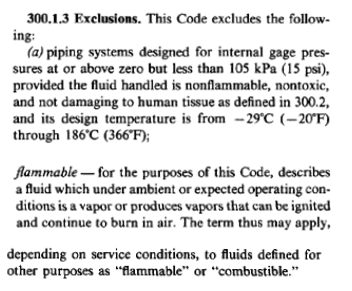Hello,
I have a vendor claiming the gas piping to a burner is exempt from B31.3 due to the design pressure being 12 PSIG and stream composition being purely natural gas. I looked into the contract code, AMSE B31.3(1996) and found the following exclusion and definition for flammable.

Given that natural gas has flammability range of approximately 5 to 15 percent in air, which is not present in that stream. Could it be considered inflammable under the ASME definition due to service conditions or is that interpretation wrong.
I have a vendor claiming the gas piping to a burner is exempt from B31.3 due to the design pressure being 12 PSIG and stream composition being purely natural gas. I looked into the contract code, AMSE B31.3(1996) and found the following exclusion and definition for flammable.

Given that natural gas has flammability range of approximately 5 to 15 percent in air, which is not present in that stream. Could it be considered inflammable under the ASME definition due to service conditions or is that interpretation wrong.
